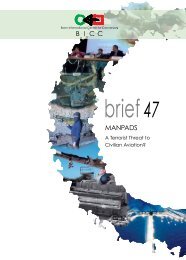egypt-final-presidential-elections-2012
egypt-final-presidential-elections-2012
egypt-final-presidential-elections-2012
You also want an ePaper? Increase the reach of your titles
YUMPU automatically turns print PDFs into web optimized ePapers that Google loves.
The Carter Center<br />
Presidential Election in Egypt<br />
unavoidable, future electoral management bodies<br />
should refrain from making last-minute changes<br />
unless absolutely necessary. A stable set of laws and<br />
procedures, coupled with<br />
proper training on the<br />
application of the law and<br />
procedures, will reduce<br />
misunderstanding of<br />
electoral procedures by<br />
voters and other electoral<br />
stakeholders.<br />
Electoral System<br />
Egypt’s international<br />
commitments do not<br />
prescribe the type of<br />
electoral system to be<br />
used, only that it upholds fundamental rights and<br />
freedoms. For the <strong>presidential</strong> election, Egypt is a<br />
single electoral district. The candidate receiving<br />
an absolute majority (more than 50 percent) of<br />
the valid votes cast nationwide in the first round<br />
is declared the winner. In the event no candidate<br />
receives an absolute majority in the first round, as was<br />
the case in <strong>2012</strong>, the two candidates receiving the<br />
greatest number of valid votes participate in a second<br />
round runoff election to determine who is elected<br />
president. 61<br />
Election Management<br />
On March 7, <strong>2012</strong>, the PEC invited Egypt’s voters to<br />
participate in the <strong>presidential</strong> election on May 23–24,<br />
<strong>2012</strong>, with a second round runoff election, if required,<br />
to be held on June 16–17, <strong>2012</strong>. 62 The announcement<br />
also defined the candidate nomination period<br />
as March 10–April 8 and triggered the closure of the<br />
national identity database (NID) on March 8 63 for the<br />
purpose of preparing the voters’ list. Simultaneously,<br />
the PEC issued a decision to establish an out-ofcounty<br />
voting process for Egyptians abroad to vote<br />
by mail or at Egypt’s diplomatic missions. 64<br />
For polling and counting operations, Egypt<br />
Articles 30 and 38 of the Law Regulating<br />
the Presidential Election were amended<br />
to introduce counting at polling stations.<br />
The Carter Center welcomes these<br />
amendments, which also require presiding<br />
judges to announce results at the polling<br />
station and to provide copies of the polling<br />
station count to the candidates’ agents.<br />
25<br />
maintained 351 65 police administrative areas of operational<br />
responsibility. Each of Egypt’s 27 governorates<br />
contained multiple areas of responsibility, and each<br />
area of responsibility<br />
corresponded to the PEC<br />
DGCs with responsibility<br />
for polling centers within<br />
their areas of geographic<br />
coverage. Within a<br />
polling center, there were<br />
multiple polling stations,<br />
each presided over by a<br />
judge. 66 Requiring that a<br />
judge oversee each polling<br />
station limits the number<br />
of possible polling stations<br />
on any election day to<br />
the number of judges<br />
available and willing to serve as a chairperson. The<br />
Carter Center recommends that this arrangement be<br />
revisited for future <strong>elections</strong>.<br />
Voting operations were originally officially scheduled<br />
between 8:00 a.m. and 8:00 p.m. 67 over two days<br />
61 Article 40 of the Law Regulating the Presidential Election allows for<br />
the participation of more than two candidates in the second round in<br />
the unlikely event that there is a tie between two or more candidates<br />
receiving the second greatest number of valid votes in the first round.<br />
62 PEC Decision No. 5 of <strong>2012</strong><br />
63 The PEC’s decisions come into effect on the day that they are printed<br />
in the official gazette.<br />
64 OCV took place May 11–17 for the first round and June 3–9 for the<br />
second round. OCV was established in PEC Decision No. 4 of <strong>2012</strong>.<br />
65 At the outset of the transition, there were 359 police AoRs, which<br />
were subsequently reduced to 353 AoRs. As a result, two police AoRs<br />
only had one voter registered and were transferred to the nearest AoR,<br />
bringing the total to 351 AoRs.<br />
66 Polling stations were classified into three categories for logistical<br />
purposes, namely the allocation of polling materials, such as, inter alia,<br />
voting booths, ballot books, and ballot boxes. The first category of polling<br />
stations accommodates up to 2,000 voters, the second accommodates<br />
between 2,001 and 4,000 voters, and the third category accommodates<br />
between 4,001 and 6,000 voters. However, in very few cases, especially<br />
in remote areas, the number of voters registered at some polling stations<br />
was as low as a few hundred voters, and conversely, some polling stations<br />
accommodated more than 6,000 voters.<br />
67 The voting times were extended to 9 p.m. for both days of the first<br />
round (PEC Decision No. 26 dated May 23, <strong>2012</strong>, and Decision No.<br />
27 dated May 24, <strong>2012</strong>) and until 10 p.m. for the second round. (No<br />
accompanying PEC decision was found on its website.)



